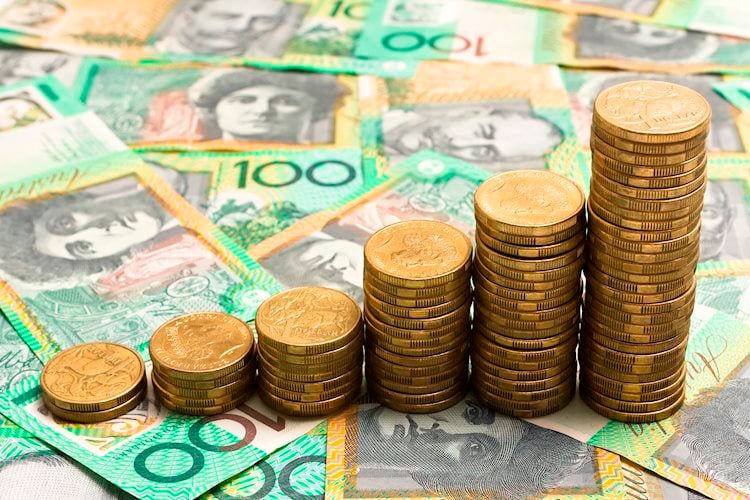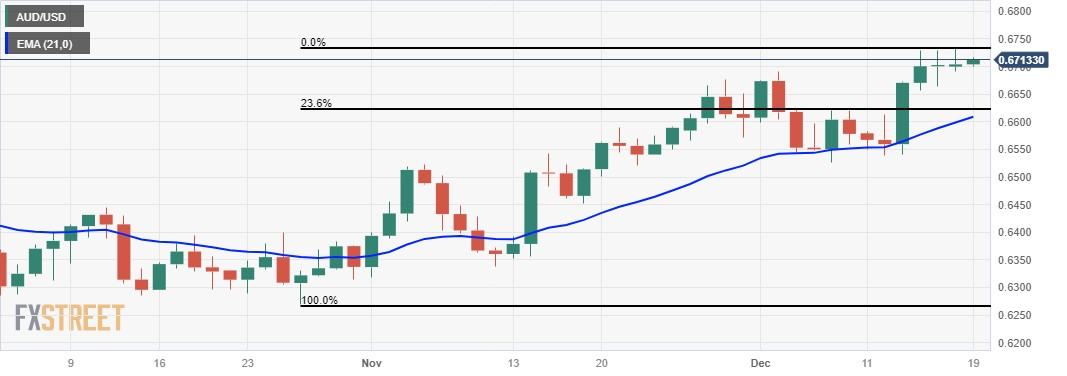- Australian Dollar remains bullish after the RBA meeting minutes release.
- Australian policymakers suggest further tightening will depend on data and assessment of risks.
- New York Fed President John Williams dismissed speculation regarding a potential rate cut in March.
The Australian Dollar (AUD) moves on an upward trajectory for the sixth successive session on Tuesday as the US Dollar remains in negative territory. The AUD/USD pair got a boost as traders anticipated rate cuts from the Federal Reserve (Fed), putting pressure on the US Dollar (USD). Additionally, Australia’s robust employment results and rising incomes are signs of economic resilience, providing strong support for the Australian Dollar.
Australia’s Meeting Minutes are released by the Reserve Bank of Australia (RBA). The board observed “encouraging signs” of progress regarding inflation, emphasizing the need for this positive trend to persist. The decision on whether further tightening is necessary will be based on data and a thorough assessment of risks.
RBA board expressed the importance of waiting for additional data to evaluate the balance of risks, considering the potential for inflation to remain elevated for an extended period balanced against the risk of a more pronounced slowdown in demand. Additionally, the board took note that the RBA staff forecast anticipated inflation returning to the upper end of the band by the end of 2025 rather than the midpoint.
The US Dollar Index (DXY) holds steady as it awaits fresh developments from the United States (US) economy. The DXY could find support in improved yields on US Treasury bonds. Investors will focus on Building Permits and Housing Starts from the United States (US) on Tuesday. Furthermore, on Wednesday, the People’s Bank of China (PBoC) is scheduled to announce its Interest Rate Decision.
Federal Reserve (Fed) Bank of New York President John Williams offered a counterpoint in contrast to speculation about a March rate cut from the Federal Open Market Committee (FOMC). Moreover, San Francisco Fed President Mary Daly stated that even with three rate cuts next year, the Fed would maintain a relatively restrictive stance. Speculating on which meetings might see a change in the policy stance for the upcoming year is premature. According to Daly, there is ongoing work, and the focus extends beyond just bringing inflation down to 2%.
Daily Digest Market Movers: Australian Dollar remains hawkish amid a subdued US Dollar
- The preliminary Judo Bank Composite PMI improved to 47.4 from the previous reading 46.2. The Manufacturing PMI for the same period registered 47.8, a slight increase from the prior figure of 47.7. Additionally, the Services PMI grew to 47.6 compared to the previous reading of 46.0.
- Australia’s Consumer Inflation Expectations for December eased at 4.5% against the previous figures of 4.9%.
- Australian Trade Minister Don Farrell stated that he believes China will eliminate punitive tariffs on Australian wine. China has already lifted trade restrictions on most Australian exports, signaling a gradual improvement in the relations between the two countries.
- Chicago Fed President Austan Goolsbee didn’t dismiss the possibility of a rate cut in the Fed’s March meeting. Furthermore, Atlanta Fed President Raphael Bostic hinted at a potential interest rate cut in the third quarter of 2024, contingent on inflation following the anticipated trajectory.
- Federal Reserve (Fed) maintained interest rates at 5.5% in its December policy meeting as expected. Markets are now projecting three rate cuts for 2024.
- US S&P Global Services PMI rose to 51.3 from 50.8 prior. While Manufacturing PMI declined to 48.2 from 49.4.
Technical Analysis: Australian Dollar maintains its position above 0.6700
The Australian Dollar trades higher around 0.6720 on Tuesday, maintaining its upward momentum after reaching a new five-month high at 0.6735 on Monday. The prevailing bullish sentiment suggests a potential for the AUD/USD pair to surpass the recent peak and approach the key resistance level at 0.6750. On the downside, significant support is situated at 0.6700. A breach below this level might lead the AUD/USD pair towards the critical zone at 0.6650, followed by the 23.6% Fibonacci retracement at 0.6622. Subsequently, the 21-day Exponential Moving Average (EMA) at 0.6609 could act as a support before reaching the psychological level at 0.6600.
AUD/USD: Daily Chart
Australian Dollar price today
The table below shows the percentage change of Australian Dollar (AUD) against listed major currencies today. Australian Dollar was the strongest against the Japanese Yen.
| USD | EUR | GBP | CAD | AUD | JPY | NZD | CHF | |
| USD | -0.03% | -0.08% | -0.01% | -0.27% | 0.36% | -0.28% | -0.10% | |
| EUR | 0.05% | -0.03% | 0.04% | -0.23% | 0.40% | -0.22% | -0.07% | |
| GBP | 0.08% | 0.03% | 0.07% | -0.19% | 0.44% | -0.21% | -0.02% | |
| CAD | 0.01% | -0.03% | -0.06% | -0.26% | 0.35% | -0.27% | -0.10% | |
| AUD | 0.28% | 0.25% | 0.22% | 0.28% | 0.63% | 0.01% | 0.18% | |
| JPY | -0.39% | -0.41% | -0.46% | -0.40% | -0.65% | -0.67% | -0.50% | |
| NZD | 0.28% | 0.23% | 0.20% | 0.26% | -0.01% | 0.72% | 0.16% | |
| CHF | 0.12% | 0.07% | 0.06% | 0.12% | -0.15% | 0.50% | -0.15% |
The heat map shows percentage changes of major currencies against each other. The base currency is picked from the left column, while the quote currency is picked from the top row. For example, if you pick the Euro from the left column and move along the horizontal line to the Japanese Yen, the percentage change displayed in the box will represent EUR (base)/JPY (quote).
Australian Dollar FAQs
One of the most significant factors for the Australian Dollar (AUD) is the level of interest rates set by the Reserve Bank of Australia (RBA). Because Australia is a resource-rich country another key driver is the price of its biggest export, Iron Ore. The health of the Chinese economy, its largest trading partner, is a factor, as well as inflation in Australia, its growth rate and Trade Balance. Market sentiment – whether investors are taking on more risky assets (risk-on) or seeking safe-havens (risk-off) – is also a factor, with risk-on positive for AUD.
The Reserve Bank of Australia (RBA) influences the Australian Dollar (AUD) by setting the level of interest rates that Australian banks can lend to each other. This influences the level of interest rates in the economy as a whole. The main goal of the RBA is to maintain a stable inflation rate of 2-3% by adjusting interest rates up or down. Relatively high interest rates compared to other major central banks support the AUD, and the opposite for relatively low. The RBA can also use quantitative easing and tightening to influence credit conditions, with the former AUD-negative and the latter AUD-positive.
China is Australia’s largest trading partner so the health of the Chinese economy is a major influence on the value of the Australian Dollar (AUD). When the Chinese economy is doing well it purchases more raw materials, goods and services from Australia, lifting demand for the AUD, and pushing up its value. The opposite is the case when the Chinese economy is not growing as fast as expected. Positive or negative surprises in Chinese growth data, therefore, often have a direct impact on the Australian Dollar and its pairs.
Iron Ore is Australia’s largest export, accounting for $118 billion a year according to data from 2021, with China as its primary destination. The price of Iron Ore, therefore, can be a driver of the Australian Dollar. Generally, if the price of Iron Ore rises, AUD also goes up, as aggregate demand for the currency increases. The opposite is the case if the price of Iron Ore falls. Higher Iron Ore prices also tend to result in a greater likelihood of a positive Trade Balance for Australia, which is also positive of the AUD.
The Trade Balance, which is the difference between what a country earns from its exports versus what it pays for its imports, is another factor that can influence the value of the Australian Dollar. If Australia produces highly sought after exports, then its currency will gain in value purely from the surplus demand created from foreign buyers seeking to purchase its exports versus what it spends to purchase imports. Therefore, a positive net Trade Balance strengthens the AUD, with the opposite effect if the Trade Balance is negative.

